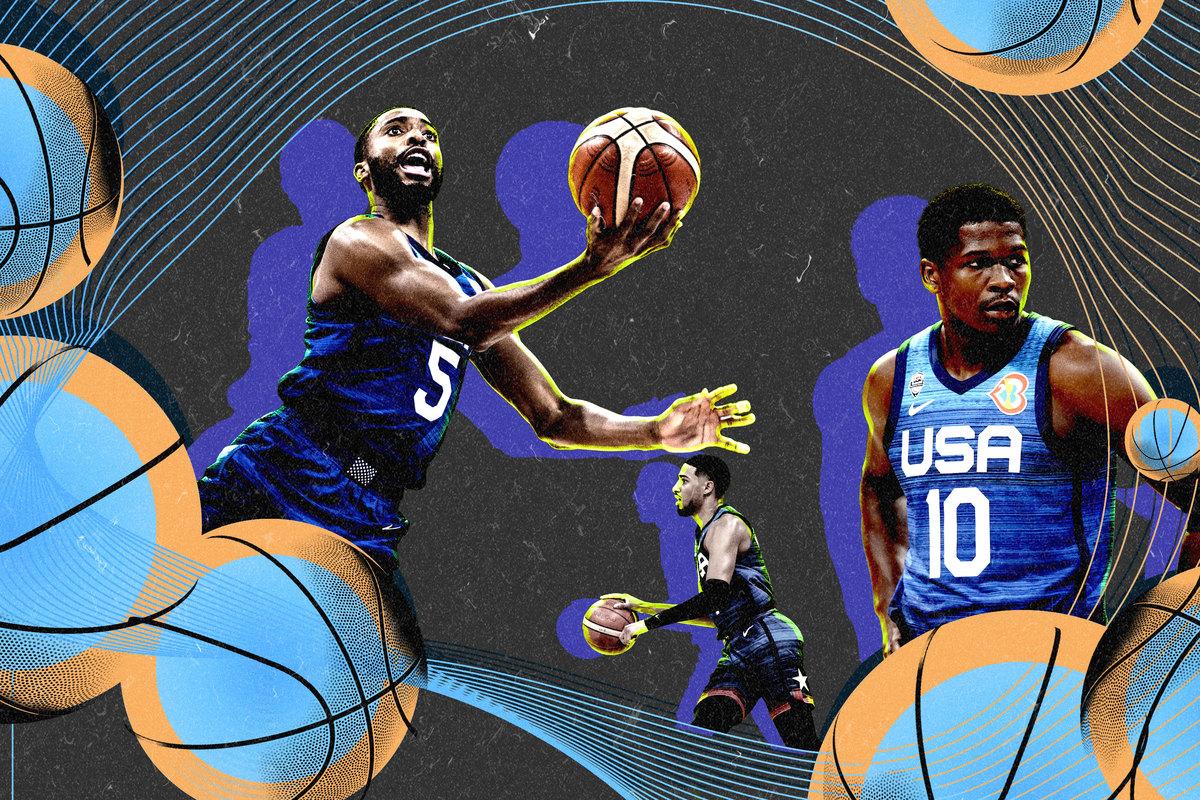
Team USA got a much-needed morale boost in the quarterfinal round of the 2023 FIBA World Cup—a 37-point disassembling of Italy, 100-63, on Tuesday. Two consecutive nail-biters—against Montenegro (which they won) and Lithuania (which they lost)—last week had sowed seeds of doubt about the youngest squad in the tournament, a fresh-faced team largely consisting of players who bear enormous burdens of proof for themselves, their respective NBA teams, and their country. Averaging out at 24.1 years old, this is the youngest team the U.S. has trotted out in international play since the 2004 Olympics introduced a still-teenage LeBron James to FIBA play—and that team had a prime Allen Iverson and Tim Duncan rocking the cradles. To paraphrase Anthony Edwards, this 2023 squad doesn’t have a Kobe. (Though Edwards, rocking the Mamba’s now-iconic no. 10, has certainly tried to assume the position.)
Few Team USA rosters outside of Olympic competition do have a star on that level. The hand-wringing panic over roster construction for FIBA competition is something of a time-honored tradition at this point. The 2019 World Cup roster—which featured pre-prime versions of Jayson Tatum, Jaylen Brown, and Donovan Mitchell—was considered the worst version of Team USA since NBA players were integrated in 1992. (They backed it up by placing seventh in ’19, the worst-ever result for the U.S. in a major international basketball tournament.) At the very least, despite boasting an even less talented roster this year, the U.S. has guaranteed itself no worse than fourth place in 2023 and clinched a spot in next year’s Olympic Games in Paris.
Without the threat of ignominy, it’s easier to focus on the talent this team is fostering: Edwards’s all-out assertiveness on both ends of the floor has painted him as a clear potential superstar waiting in the wings; Jalen Brunson and Tyrese Haliburton have lived up to their billing as pace-setting generals, which portends well for their respective futures as lead guards; and Paolo Banchero, Mikal Bridges, and Austin Reaves have been essential in their adaptiveness. On Tuesday, Bridges’s two-way play took center stage—he scored 24 points on 8-for-11 shooting and ruined Italy’s flow of play with his length and defensive omnipresence. It was an unexpected but welcome star turn for Bridges, who had arguably been the team’s most important two-way player, leading it in plus-minus all tournament long.
Yes, there is no Kobe on this team, but it didn’t need one against Italy, which had overachieved throughout the tournament despite having the worst shooting percentages of any team that made it to the quarterfinal stage. Without the 7-foot interior hubs (Nikola Vucevic for Montenegro, Jonas Valanciunas and Donatas Motiejunas for Lithuania) that Team USA’s two previous opponents had, Italy didn’t enjoy the luxury of playing inside out, and it also didn’t have the bodies to win the possession battle on the glass. Instead, it had to rely on tough shotmaking from five-out alignments, playing to the supposed strengths of a roster full of perimeter-oriented players who weren’t shooting well to begin with. Simone Fontecchio, Italy’s leading scorer, is a decisive sharpshooting wing who, throughout the tournament, had capitalized on beating defenses to his spots off the ball and drilling shots off ball movement. He still put up 18 points, but against the USA’s versatile and long-armed pressure, Fontecchio looked rushed in the first half, forcing more off-balance pull-up jumpers than he’s accustomed to.
The constraints of Italy’s roster construction necessitated a sort of small ball for the European team that played right into USA’s biggest strengths. Jaren Jackson Jr., whose greatest weakness (a fatal attraction to foul trouble) played a monumental role in the loss to Lithuania, once again couldn’t stay on the floor, logging two early first-quarter fouls in less than three minutes. Luckily, it didn’t matter in this matchup—though it’s arguably the most pressing issue left to address on Team USA’s road to the championship game. The urgency that had been absent against Lithuania and Montenegro resurfaced; the USA pressed early and often, hurrying Italy—one of the slowest-paced teams in the tournament—and made quick and decisive help rotations in the paint to make up for JJJ’s non-presence. Moving forward to a semifinal round that will feature either Germany or Latvia, two of the hottest shooting teams in the tournament, Team USA will have to be just as proactive on defense as it was against Italy, unless it wants to face the same math problem from behind the arc that Lithuania subjected it to.
It’s unfair to the game plan and execution of Lithuania’s players and coaching staff to reduce its win to a “wake-up call” for the U.S., though it’s hard to see the U.S. effort against Italy on both ends of the floor and not consider it a critical response. Regardless, these games are the kinds of invaluable reps that make young teams better. We should be way past dwelling on what can’t be controlled as far as roster construction. Yes, perhaps the roster could have used one more proven rim protector given what we’ve long known about Jackson’s style and manner of defense, but the team will do what it was built to: adapt. Half of the roster has dealt with being traded. Less than a handful have been given a clear runway to be the best players on their own NBA squads. Most have had to prove that their talents are beyond typecasting. As the U.S. moves into the semifinals, the method to this roster’s madness is beginning to reveal itself—without the benefit of megastars, maybe the most prudent approach is to bring in a bunch of young players who have thrived by taking nonlinear paths of development and to test that malleability in a two-week tournament. (That, and having one of the most athletic and aggressive young players in the world in Edwards to take the team home—perhaps the most impressive stat in Tuesday’s win was that Edwards scored only three points.)
Seen through the lens of growth, while this year’s roster clearly doesn’t stack up to teams of the past, it doesn’t feel dire the way it did in 2002, when Team USA thought it was wise to start a 37-year-old Reggie Miller at shooting guard in a serious international basketball competition. It might be best to start considering the World Cup as a sort of proving ground for young stars, a third place of high-stakes basketball development that clarifies the path forward for both the individual and Team USA as an organization. FIBA worked its PR magic to rebrand the World Championship as the World Cup in 2010, hoping to attach itself to the luster of FIFA’s grandest stage. But the FIBA World Cup will always come second to the Olympics, where the NBA’s best similarly hope to align themselves with the global legacy of the Dream Teams and Redeem Team—some of the greatest assemblages of talent in all of international athletic competition. The World Cup is a different platform, but no less meaningful for the would-be stars who take part. The U.S.’s World Cup roster may never feature its A-list NBA stars again, but that’s OK. Take a look back at the roster in a few years. Objects in the rearview mirror are closer than they appear.

